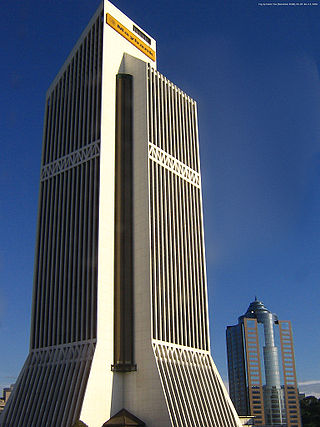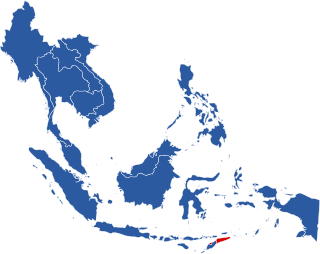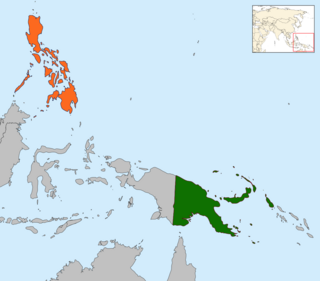

The possibility of accession of Papua New Guinea to the Association of Southeast Asian Nations is currently a matter of discussion.


The possibility of accession of Papua New Guinea to the Association of Southeast Asian Nations is currently a matter of discussion.
As early as 1987, Papua New Guinea's membership in the Pacific Islands Forum (PIF) was viewed as an obstacle to its joining ASEAN. [1] In 2009, the country asked for the support of the Philippines in its ASEAN bid, however, no official response was heard as it was election season. The incumbent conservative Filipino administration which Papua New Guinea contacted and supported, dramatically lost to a more liberal administration in the 2010 Philippine election. [2]
Indonesia is the only ASEAN member supporting Papua New Guinea's membership. A grassroots level of support exists in the Philippines, although there is caution due to the country's discriminatory policies on human rights, notably on LGBT rights and the issue of West Papua. Singapore, Malaysia, and Brunei have shown dissatisfaction over Papua New Guinea's economic status which has hindered its acceptance into ASEAN. Laos and Myanmar have no official position in regards to the country's ASEAN application.
Papua New Guinea has enjoyed observer status in ASEAN since 1976. Benefits Papua New Guinea has cited to ASEAN members from the country's accession might include tapping into Papua New Guinea's lead industries such as oil and gas, mining and seafood. [3] In 2015, Papua New Guinea appointed a special envoy to resolve issues related to ASEAN, demonstrating its determination to promote full membership of ASEAN. Papua New Guinea is also taking the necessary steps to prepare for integration. [4]
Violent crime, political instability, poor infrastructure, discriminatory laws, and unskilled labor [5] are obstacles preventing Papua New Guinea from joining, as well as the fact that the country is closer, culturally and geographically, to the Pacific islands to its east and that it is historically and financially tied more closely to Australia in the south, [6] as unlike East Timor, PNG was not directly administered by the colonial governments that controlled the Southeast Asian colonies (with the exception of Thailand). PNG was partially administered by Germany before being administered by Australia (with a brief stint under British control in the 1800's) until its independence. This is in contrast to East Timor, which was occupied by Indonesia and is commonly regarded as part of Southeast Asia. [7]

Brunei, officially State of Brunei, and formally Brunei Darussalam, is a country in Southeast Asia, situated on the northern coast of the island of Borneo. Apart from its coastline on the South China Sea, it is completely surrounded by the Malaysian state of Sarawak, with its territory bifurcated by the Sarawak district of Limbang. Brunei is the only sovereign state entirely on Borneo; the remainder of the island is divided between its multi-landmass neighbours of Malaysia and Indonesia. As of 2023, the country had a population of 455,858, of whom approximately 180,000 resided in the capital and largest city of Bandar Seri Begawan. Its official language is Malay and Islam is the state religion of the country, although other religions are nominally tolerated. The government of Brunei is an constitutional absolute monarchy ruled by the Sultan, and it implements a fusion of English common law and jurisprudence inspired by Islam, including sharia.

Papua New Guinea, officially the Independent State of Papua New Guinea, is a country in Oceania that comprises the eastern half of the island of New Guinea and its offshore islands in Melanesia. It shares its only land border with Indonesia to the west and it is directly adjacent to Australia to the south and the Solomon Islands to the east. Its capital, located along its southeastern coast, is Port Moresby. The country is the world's third largest island country, with an area of 462,840 km2 (178,700 sq mi).

Southeast Asia is the geographical south-eastern region of Asia, consisting of the regions that are situated south of China, east of the Indian subcontinent, and north-west of mainland Australia which is part of Oceania. Southeast Asia is bordered to the north by East Asia, to the west by South Asia and the Bay of Bengal, to the east by Oceania and the Pacific Ocean, and to the south by Australia and the Indian Ocean. Apart from the British Indian Ocean Territory and two out of 26 atolls of Maldives in South Asia, Maritime Southeast Asia is the only other subregion of Asia that lies partly within the Southern Hemisphere. Mainland Southeast Asia is entirely in the Northern Hemisphere. East Timor and the southern portion of Indonesia are the parts of Southeast Asia that lie south of the Equator.

The Association of Southeast Asian Nations, commonly as ASEAN, is a political and economic union of 10 states in Southeast Asia. Together, its member states represent a population of over 600 million over a land area of 4.5 million km2 (1.7 million sq mi). The bloc generated a purchasing power parity (PPP) gross domestic product (GDP) of around US$10.2 trillion in 2022, constituting approximately 6.5% of global GDP (PPP). ASEAN member states include some of the fastest growing economies in the world.

Asia-Pacific Economic Cooperation is an inter-governmental forum for 21 member economies in the Pacific Rim that promotes free trade throughout the Asia-Pacific region. Following the success of ASEAN's series of post-ministerial conferences launched in the mid-1980s, APEC started in 1989, in response to the growing interdependence of Asia-Pacific economies and the advent of regional trade blocs in other parts of the world; it aimed to establish new markets for agricultural products and raw materials beyond Europe. Headquartered in Singapore, APEC is recognized as one of the highest-level multilateral blocs and oldest forums in the Asia-Pacific region, and exerts significant global influence.

Papua New Guinea's foreign policy reflects close ties with Australia and other traditional allies and cooperative relations with neighboring countries. Its views on international political and economic issues are generally moderate.

The ASEAN Free Trade Area (AFTA) is a trade bloc agreement by the Association of Southeast Asian Nations supporting local trade and manufacturing in all ASEAN countries, and facilitating economic integration with regional and international allies. It stands as one of the largest and most important free trade areas (FTA) in the world, and together with its network of dialogue partners, drove some of the world's largest multilateral forums and blocs, including Asia-Pacific Economic Cooperation, East Asia Summit and Regional Comprehensive Economic Partnership.

Malayan Banking Berhad is a Malaysian universal bank, with key operating "home markets" of Malaysia, Singapore, and Indonesia. According to the 2020 Brand Finance report, Maybank is Malaysia's most valuable bank brand, the fourth-top brand amongst the Asean countries and ranked 70th among the world’s most valuable bank brands.

The ASEAN Summit is a biannual meeting held by the members of the Association of Southeast Asian Nations (ASEAN) in relation to economic, political, security, and socio-cultural development of Southeast Asian countries. In addition, it serves as a prominent regional (Asia) and international (worldwide) conference, with world leaders attending its related summits and meetings to discuss various problems and global issues, strengthening co-operation, and making decisions. The summit has been praised by world leaders for its success and ability to produce results on a global level.

The East Asia Summit (EAS) is a regional forum held annually by leaders of, initially, 16 countries in the East Asian, Southeast Asian, South Asian and Oceanian regions, based on the ASEAN Plus Six mechanism. Membership expanded to 18 countries including Russia and the United States at the Sixth EAS in 2011. Since its establishment, ASEAN has held the central role and leadership in the forum. EAS meetings are held after the annual ASEAN leaders' meetings, and plays an important role in the regional architecture of Asia-Pacific. The first summit was held in Kuala Lumpur, Malaysia on 14 December 2005.

In the United States Government, the Bureau of East Asian and Pacific Affairs is part of the United States Department of State and is charged with advising the Secretary of State and Under Secretary of State for Political Affairs on matters of the Asia-Pacific region, as well as dealing with U.S. foreign policy and U.S. relations with countries in the region. It is headed by the Assistant Secretary of State for East Asian and Pacific Affairs, who reports to the Under Secretary of State for Political Affairs.

As of 2010, the Association of Southeast Asian Nations (ASEAN) has 10 member states, one candidate member state, and one observer state.

The Brunei Darussalam–Indonesia–Malaysia–Philippines East ASEAN Growth Area (BIMP-EAGA) is a cooperation initiative established in 1994 to spur development in remote and less developed areas in the four participating Southeast Asian countries.

The accession of East Timor to the Association of Southeast Asian Nations is a process that started following the independence of the country in 2002 when its leaders stated that it had made a "strategic decision" to become a member state of the Association of Southeast Asian Nations (ASEAN) in the future. The country officially applied for membership in 2011.
The Treaty of Amity and Cooperation in Southeast Asia (TAC) is a peace treaty among Southeast Asian countries established by the founding members of the Association of Southeast Asian Nations (ASEAN), a geo-political and economic organisation of 10 countries located in Southeast Asia.

The enlargement of the Associationof Southeast Asian Nations is the process of expanding the Association of Southeast Asian Nations (ASEAN) through the accession of new member states. This process began with ASEAN's five original members, who founded the association through the signing of the Bangkok Declaration in 1967. Since then, the ASEAN's membership has grown to ten with the accession of Cambodia in 1999.

Papua New Guinea–Philippines relations are the bilateral relations of Papua New Guinea and the Philippines. Papua New Guinea has an embassy in Manila and the Philippines has an embassy in Port Moresby, which is also accredited to the Solomon Islands, Vanuatu and Fiji.

The 2020 ASEAN Para Games, officially known as the 10th ASEAN Para Games, is a cancelled biannual multi-sport event for athletes with physical disabilities which was intended to be held after the 2019 Southeast Asian Games in the Philippines. Participants were expected from 11 countries in Southeast Asia. The games, patterned after the Paralympics, was to include athletes with various disabilities.
The Timor-Leste–Indonesia–Australia Growth Triangle (TIA-GT) is a combined initiative of the regions of Eastern Indonesia, Northern Australia, and the Democratic Republic of Timor-Leste. This initiative aims to promote and foster economic growth through integrated economic development in the region that these nations reside in. The growth triangle was created in 2012, after a meeting was held by Indonesian president Susilo Bambang Yudhoyono with Prime Minister of Australia Julia Gillard and Timor-Leste Prime Minister Xanana Gusmao. The initiative aims to support economic, social, and cultural development primarily by attracting investment, developing manufacturing industries, enhancing human capital, and overall building a stronger cooperative relationship between the three countries involved. The initiative also aimed to accelerate the accession of Timor-Leste into the Association of Southeast Asian Nations (ASEAN) and to fulfill goals set by Timor-Leste's Strategic Development Plan, such as increasing the nation's economic prosperity and stability. The growth triangle is often misinterpreted as a free-trade zone; however, while there are elements of free trade agreements between Indonesia and Australia specifically, the terms of the growth triangle initiative are not directly linked to these free trade agreements, and the goals of the growth triangle do not specifically encompass free trade between the three nations.

The accession of Sri Lanka to the Association of Southeast Asian Nations began as early as 1967, making its accession process older than that of some current ASEAN members. Currently, the Sri Lankan government have yet to revive the idea.